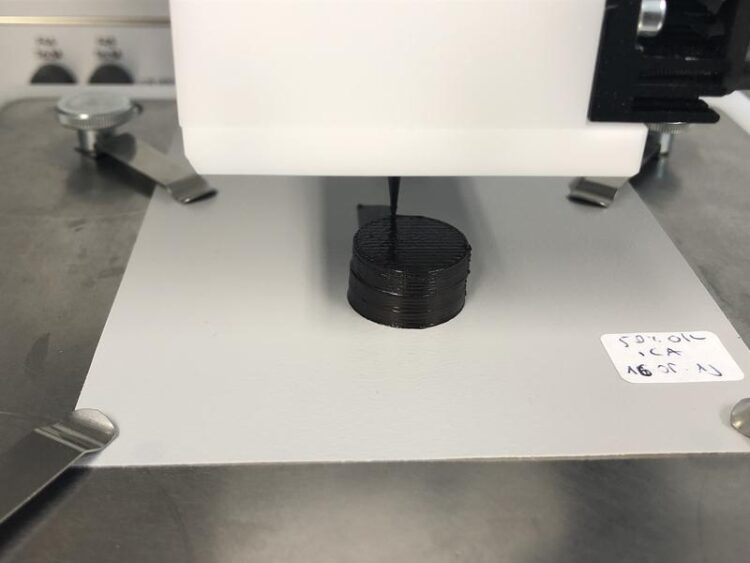From Biopaste to Bioplastic

The biopaste used to print this cylinder consists of 50 percent lignin and 50 percent cellulose.
Photo: Lisa Ebers
Forest scientists develop innovative wood-based materials for 3D printing
A viscous biopaste that is easy to process, solidifies quickly and is suitable for producing even complex structures using the 3D printing process has been developed by a research team headed by Prof. Dr. Marie-Pierre Laborie from the Chair of Forest Biomaterials at the University of Freiburg.
The wood-based biodegradable synthetic could potentially be used in lightweight construction, amongst other things. The scientists have published their initial results in the journals Applied Bio Materials and Biomacromolecules.
Lignin strengthens the cell walls of plants and causes them to turn woody (lignify) – a mechanism that helps plants to protect themselves against wind or pests. It is a waste product from paper manufacture and largely incinerated to produce bioenergy. “This is why we’re researching into alternative possibilities for making better use of this raw material in future,” says Laborie.
As a result the team started to reexamine a combination of materials which was already investigated in the 1980s by an American research team. In this system, liquid crystals based on cellulose, the main component of plant cell walls, ensure not only the strength but also the good flow properties of the biopaste.
The other component, lignin, can ‘stick together’ the microstructure in the process of creating the biosynthetic, as Robert Gleuwitz discovered in his doctoral thesis. Its orientation subsequently determines the characteristics of the biosynthetic: for instance, it can respond more rigidly or more flexibly, depending on the direction from which the force comes.
Further research work will however be necessary until industrial application is possible, for example as a composite in lightweight construction. Until now the team has used exceptionally pure lignin which is produced in a pilot biorefinery at the Fraunhofer Center for Chemical-Biotechnological Processes (CBP) in Leuna – whether the waste product from the paper industry can also be directly processed still has to be researched.
As Lisa Ebers shows in her doctoral thesis, the characteristics of the biosynthetic can also be varied in many ways, for instance by chemically processing or varying the components: Trials to date have used lignin from beech trees – if it is obtained from other plants it will have slightly different material characteristics such as different liquid crystals, even though they are all based on cellulose.
The optimal quantity ratios also differ depending on the planned application. In addition, the researchers will soon be testing an entirely different possible use: the quality of soil can be analyzed with the help of the bio-based material. This takes place by studying the degradability of lignin and cellulose in various types of soil.
The results arose from a research project by the Sustainability Center Freiburg and the Fraunhofer Society. The research and 3D printing trials took place in cooperation with Prof. Dr. Dr. Christian Friedrich and Dr. Gopakumar Sivasankarapillai at the Freiburg Materials Research Center (FMF) of the University of Freiburg and with Dr. Gilberto Siqueira in the Swiss Federal Laboratories for Materials Testing and Research (EMPA) in Dübendorf, Switzerland.
Original publications:
Gleuwitz, F.R./ Sivasankarapillai, G./ Siqueira, G./Friedrich, C./ Laborie, M.-P. G. (2020): Lignin in Bio-Based Liquid Crystalline Network Material with Potential for Direct Ink Writing. In: Applied Bio Materials.
https://doi.org/10.1021/acsabm.0c00661
Gleuwitz, F.R./ Sivasankarapillai, G./Chen, Y./Friedrich, C./ Laborie, M.-P. G. (2020): Lignin-Assisted Stabilization of an Oriented Liquid Crystalline Cellulosic Mesophase, Part B: Toward the Molecular Origin and Mechanism. In: Biomacromolecules 21/6, p. 2276−2284.
https://dx.doi.org/10.1021/acs.biomac.0c00220
Gleuwitz, F.R./Friedrich, C./Laborie, M.-P. G. (2020): Lignin-Assisted Stabilization of an Oriented Liquid Crystalline Cellulosic Mesophase, Part A: Observation of Microstructural and Mechanical Behavior. In: Biomacromolecules 21/3, p. 1069−1077.
https://dx.doi.org/10.1021/acs.biomac.9b01352
Contact:
Prof. Dr. Marie-Pierre Laborie
Institute of Forest Sciences
Faculty of Environment and Natural Resources’
University of Freiburg
Tel.: +49 761 203-97617
marie-pierre.laborie@biomat.uni-freiburg.de
Wissenschaftliche Ansprechpartner:
Prof. Dr. Marie-Pierre Laborie
Originalpublikation:
https://www.pr.uni-freiburg.de/pm-en/press-releases-2020/from-biopaste-to-biopla…
Media Contact
All latest news from the category: Materials Sciences
Materials management deals with the research, development, manufacturing and processing of raw and industrial materials. Key aspects here are biological and medical issues, which play an increasingly important role in this field.
innovations-report offers in-depth articles related to the development and application of materials and the structure and properties of new materials.
Newest articles

Webb captures top of iconic horsehead nebula in unprecedented detail
NASA’s James Webb Space Telescope has captured the sharpest infrared images to date of a zoomed-in portion of one of the most distinctive objects in our skies, the Horsehead Nebula….

Cost-effective, high-capacity, and cyclable lithium-ion battery cathodes
Charge-recharge cycling of lithium-superrich iron oxide, a cost-effective and high-capacity cathode for new-generation lithium-ion batteries, can be greatly improved by doping with readily available mineral elements. The energy capacity and…

Novel genetic plant regeneration approach
…without the application of phytohormones. Researchers develop a novel plant regeneration approach by modulating the expression of genes that control plant cell differentiation. For ages now, plants have been the…





















